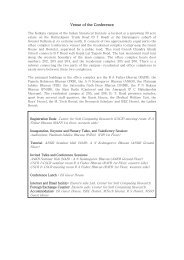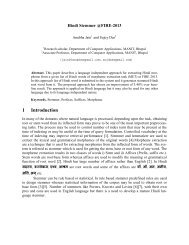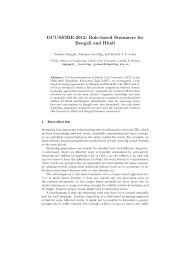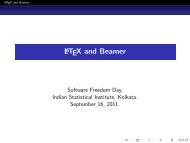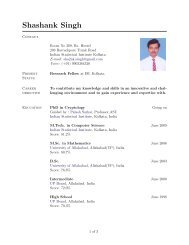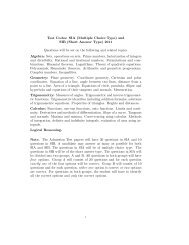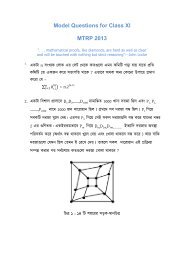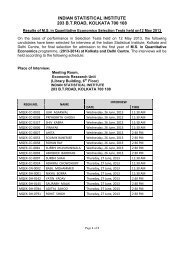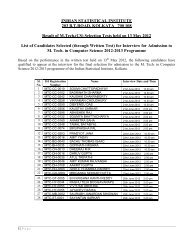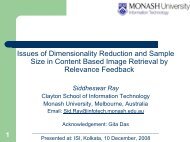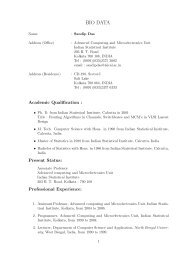A Simulated Annealing Based Multi-objective Optimization Algorithm ...
A Simulated Annealing Based Multi-objective Optimization Algorithm ...
A Simulated Annealing Based Multi-objective Optimization Algorithm ...
Create successful ePaper yourself
Turn your PDF publications into a flip-book with our unique Google optimized e-Paper software.
1121.61.41.51.2110.80.60.50.40.201.500.810.50.20 01(a)0.40.60.810.60.40.2001(b)0.20.40.60.87186.5166145.554.54121083.56342.51210.80.60.40.20.20 02(a)0.40.60.810.80.60.40.2000.22(b)0.40.60.81Fig. 9.The final non-dominated front obtained by (a) AMOSA (b) MOSA for the test problems (1) DTLZ5 (2) DTLZ6be seen from this table that AMOSA performs the best interms of Purity and Convergence for DTLZ1, DTLZ3, DTLZ5,DTLZ6. In DTLZ2 and DTLZ4 the performance of MOSA ismarginally better than that of AMOSA. NSGA-II performs theworst among all. Table V shows the Minimal Spacing valuesobtained by the 3 algorithms for DTLZ1-DTLZ6. AMOSAperforms the best in all the cases.As mentioned earlier, for comparing the performance ofMOSA (by considering the results reported in [32]), a versionof AMOSA without clustering and with unconstrained archiveis executed. The results reported here are the average over 10runs. Table VI shows the corresponding Purity, Convergenceand Minimal Spacing values. Again AMOSA performs muchbetter than MOSA for all the test problems except DTLZ4. ForDTLZ4, the MOSA performs better than that of AMOSA interms of both Purity and Convergence values. Figure 8 showsfinal Pareto-optimal front obtained by AMOSA and MOSAfor DTLZ1-DTLZ3 while Figure 9 shows the same for DTLZ5and DTLZ6. As can be seen from the figures, AMOSA appearsto be able to better approximate the front with more densesolutions as compared to MOSA.It was mentioned in [33] that for a particular test problem,almost 40% of the solutions provided by an algorithm withtruncation of archive got dominated by the solutions providedby an algorithm without archive truncation. However theexperiments we conducted did not adequately justify thisfinding. Let us denote the set of solutions of AMOSA withand without clustering as S c and S wc respectively. We foundthat for DTLZ1, 12.6% of S c were dominated by S wc , while4% of S wc were dominated by S c . For DTLZ2, 5.1% of S wcwere dominated by S c while 5.4% of S c were dominated byS wc . For DTLZ3, 22.38% of S wc were dominated by S c while0.53% of S c were dominated by S wc . For DTLZ4, all themembers of S wc and S c are non-dominating to each otherand the solutions are same. Because execution of AMOSAwithout clustering doesn’t provide more than 100 solutions.For DTLZ5, 10.4% of S wc were dominated by S c while 0.5%of S c were dominated by S wc . For DTLZ6, all the membersof S wc and S c are non-dominating to each other.To have a look at the performance of the AMOSA on afour-<strong>objective</strong> problem, we apply AMOSA and NSGA-II tothe 13-variable DTLZ2 test problem. This is referred to asDTLZ2 4. The problem has a spherical Pareto-front in fourdimensions given by the equation: f1 2 +f2 2 +f2 3 +f2 4 = 1 withf i ∈ [0, 1] for i = 1 to 4. Both the algorithms are applied for atotal of 30,000 function evaluations (for NSGA-II popsize=100and number of generations=300) and the Purity, Convergenceand Minimal Spacing values are shown in Table VII. AMOSAperforms much better than NSGA-II in terms of all the threemeasures.The proposed AMOSA and NSGA-II are also comparedfor DTLZ1 5 (9-variable 5 <strong>objective</strong> version of the test problemDTLZ1), DTLZ1 10 (14-variable 10 <strong>objective</strong> versionof DTLZ1) and DTLZ1 15 (19 variable 15 <strong>objective</strong> versionof DTLZ1). The three problems have a spherical Paretofrontin their respective dimensions given by the equation∑ Mi=1 f i = 0.5 where M is the total number of <strong>objective</strong>functions. Both the algorithms are executed for a total of1,00,000 function evaluations for these three test problems(for NSGA-II popsize=200, number of generations=500) andthe corresponding Purity, Convergence and Minimal Spacingvalues are shown in Table VII. Convergence value indicatesthat NSGA-II doesn’t converge to the true PO front whereas AMOSA reaches the true PO front for all the three cases.



